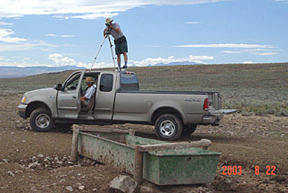|
For anyone in the least interested in how our American public lands are being damaged by livestock production, the Internet photopages assembled by Mike Hudak are an excellent and thorough photographic record showing the overwhelmingly negative impacts of public lands ranching and livestock production in the arid West.
—Jon Marvel, former executive director, Western Watersheds Project, ID
Mike Hudak’s Photo Gallery of Ranching on Western Public Lands
A photographic collection from throughout the American West showing the damaging effects of ranching on streams, forests, and grasslands.
Arizona
Dutchwoman Butte, Tonto National Forest (2000)
One of the few remaining ungrazed grasslands in the Southwest abounds in native vegetation.
Idaho
-
Burnt Creek Exclosure, BLM (2002)
Since cattle were excluded from this section of Burnt Creek in 1988 native vegetation has rebounded, and the creek has narrowed and deepened—a stark contrast to conditions on the adjacent cattle allotment.
-
Doublesprings Exclosure, Pahsimeroi Cattle and Horse Allotment,
Salmon-Challis National Forest (2003)
Lush vegetation within this livestock exclosure from 1970 contrasts with the bare ground of the surrounding grazing allotment.
-
Morgan Creek Allotment, Salmon-Challis National Forest (2002)
Long-term mismanagement of livestock grazing has resulted in widespread environmental impacts, including those to habitat of the threatened bull trout.
Montana
-
Antelope Basin Management Area, Beaverhead-Deerlodge
National Forest (2002)
View some of the cattle impacts underlying the June 2004 lawsuit challenging grazing management on important fish and wildlife habitat.
New Mexico
-
Diamond Bar Allotment, Gila National Forest (2003)
Controversy over protection of wilderness values led to this allotment’s closure in 1997. Controversy raged again in 2003 when the former permittee released several hundred head of cattle onto the allotment in violation of a federal court ruling.
Utah
-
Brumley Ridge Allotment, Manti-La Sal National Forest (2001)
Soil erosion and weeds are ranching’s legacy on this high-elevation allotment.
-
Grand Staircase-Escalante National Monument, BLM (2001)
An overview of monument areas grazed and ungrazed by livestock.
-
Grand Staircase-Escalante National Monument, Rock Creek/Mudholes
Allotment, BLM (2002)
Drought in 2000 prompted the BLM to impound the permittee’s cattle to minimize their impact on the landscape. Yet in 2002, cattle that had eluded that roundup continued inflicting damage.
-
Ken’s Lake & Behind The Rocks Allotments, State Trust Lands (2002)
Cattle grazing during long-term drought has degraded the community of native vegetation.
Wyoming
-
Cumberland/Uinta Allotment, BLM (2002)
Riparian and upland exclosures provide dramatic contrast to adjacent areas grazed by cattle. Soil erosion and streams stripped of vegetation are the norm throughout the allotment.
-
Granite Mountain Open Allotment, BLM (2001)
An introduction to how cattle have damaged the high cold desert wetlands of the region.
-
Granite Mountain Open Allotment, BLM (2002)
Continuation of the previous year’s investigation into the damage ranching has inflicted on the region’s wetlands, plus a stark contrast between a cattle-grazed riparian zone within the allotment and its ungrazed continuation on adjacent private property.
-
Green Mountain Common Allotment, BLM (2001)
A brief introduction to livestock-inflicted wetland damage and the compounding effects of prolonged drought.
-
Smithsfork Allotment, BLM (2001)
Fifteen years after the BLM declared this allotment its number one priority out of thirty-nine allotments in Wyoming, environmental conditions had not improved. Our tour includes entrenched streams and cattle-trampled wetlands.
|
